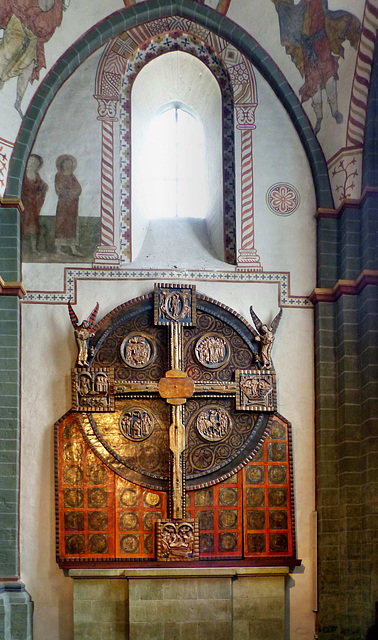Location
See also...
Keywords
Authorizations, license
-
Visible by: Everyone -
All rights reserved
-
186 visits
Soest - Hohnekirche


With a population of about 10.000 Soest was the most important town in Westphalia within the 11th and 12th century.
The "Soester Stadtrecht" ("Soest city law") is the oldest city law, documented in German territory. Soest was one of the most important Hanseatic cities in medieval times. During the "Soester Fehde" ("Soest Feud") it liberated itself from the Bishop of Cologne, who controlled Westphalia.
During and after the Thirty Years' War, Soest suffered a tremendous loss population and influence. At the lowest point in 1756, it had only 3,600 citizens.
Soest has still a couple of wonderful medieval, Romanesque churches, built with the regional greenish sandstone. The "Hohnekirche" (officially "St. Maria zur Höhe") is one of them. The church was built in its present form from 1180 and is one of the oldest hall churches in Westphalia. It replaced an older church here.
This giant triumph-cross is a very unique piece of art here. This "Scheibenkreuz" ("plate cross"), created ~1200, is the only one in "mainland" Europe and the oldest. Something similar can be found almost only on the island of Gotland in Sweden. However, these crosses are younger.
Here nail marks exist, so originally Christ body was nailed to the cross. The plate cross, made of spruce and pine, has a height of 3.89 m and diameter of 2.72 m.
Soest has had a very strong position within the Hanse League so there were for sure ties to Northern Europe, where this cross may have been created.
The "Soester Stadtrecht" ("Soest city law") is the oldest city law, documented in German territory. Soest was one of the most important Hanseatic cities in medieval times. During the "Soester Fehde" ("Soest Feud") it liberated itself from the Bishop of Cologne, who controlled Westphalia.
During and after the Thirty Years' War, Soest suffered a tremendous loss population and influence. At the lowest point in 1756, it had only 3,600 citizens.
Soest has still a couple of wonderful medieval, Romanesque churches, built with the regional greenish sandstone. The "Hohnekirche" (officially "St. Maria zur Höhe") is one of them. The church was built in its present form from 1180 and is one of the oldest hall churches in Westphalia. It replaced an older church here.
This giant triumph-cross is a very unique piece of art here. This "Scheibenkreuz" ("plate cross"), created ~1200, is the only one in "mainland" Europe and the oldest. Something similar can be found almost only on the island of Gotland in Sweden. However, these crosses are younger.
Here nail marks exist, so originally Christ body was nailed to the cross. The plate cross, made of spruce and pine, has a height of 3.89 m and diameter of 2.72 m.
Soest has had a very strong position within the Hanse League so there were for sure ties to Northern Europe, where this cross may have been created.
- Keyboard shortcuts:
Jump to top
RSS feed- Latest comments - Subscribe to the comment feeds of this photo
- ipernity © 2007-2024
- Help & Contact
|
Club news
|
About ipernity
|
History |
ipernity Club & Prices |
Guide of good conduct
Donate | Group guidelines | Privacy policy | Terms of use | Statutes | In memoria -
Facebook
Twitter

Sign-in to write a comment.